From April 29th to May 10th, 2016, a team made up of Seb F5UFX, Flo F5CWU, Vincent F4BKV, Gil F4FET, Yann F1NGP, Pat F2DX, Jack F6BEE, Pascal F5PTM, Diégo F4HAU, Chris EA3NT, went to Juan de Nova, an island located between Madagascar and Mozambique. The island is flat, and covers an area of 4.4 kilometers square. It is surrounded by a coral reef which harbours a vast lagoon. Forests, mainly of Casuarinaceae (Le Filao), cover about half the island. It is named after a Portuguese captain Joao da Nova who discovered it in 1501. In the absence of foreign presence, the island is attached to the colonial empire of France in 1896 and passed under French flag the following year. Since 2007, it is attached like the other Scattered islands to the administration of the TAAF (Terres Australes et Antarctiques Françaises).
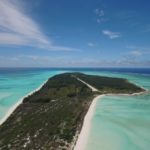
The thud of the chain pulling up the anchor of the Antsiva puts an end to the last moments of calm prior to our departure for Mayotte (FH). All operators stand on the deck quietly looking at the last view of the Island, before setting off on the ocean journey ahead. On the shore, the static sky blue colour contrasts with the deep green of the luxuriant végétation stretching along the beach. We salute the solitary gendarme standing on the beach, craning his neck and bidding us bon voyage. He watched until we were just a speck in the distance.It was only then we thought about our last two weeks on Juan de Nova and the energy spent overcoming the various technical and physical challenges required of such an expedition, the culmination of a year of hard work, of preparation, planning and sacrifice. We felt extremely fortunate in getting the opportunity to visit again one of the scattered islands. Our time on Juan de Nova passed very quickly. We were all now in a good and light hearted mood, convinced that we had done everything possible to make our endeavour a success.
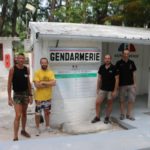
After two days sailing, we arrived at Juan de Nova late in the afternoon, earlier than expected, due to the marine currents in the Mozambique channel between there and Mayotte. We could see the shoreline of Juan de Nova almost one kilometer away. What struck us, was the contrast between the immaculate white sand which seemed to spout out from the water and the filaos (trees) which form a thick and dark layer. The last moments of daylight provided a red colour to the landscape before the darkness quickly settled. We could see the red lantern of the lighthouse close to the western point of the Island.. It warns passing ships of the stretch of land between Madagascar and Mozambique.Tuesday, March 29th 2016 – Before the first lights of dawn, the excitement among the participants began to peak aboard the « Antsiva », a 28m long yacht specialising in adventure cruising and trips such as the one we had set out upon. Although we had spent the night in a calm mooring, the growing excitement did not bring an easy sleep. It was hard to accept that the fifth rarest country in the world was just a short distance away.
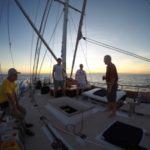
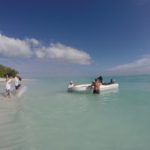
No alarm clocks were necessary as each team member, was anxious to make ready for the day ahead. Beds, were abandoned and even breakfast was short lived as we began to assemble equipment on the deck in preparation of transport to the shore. Before dawn, we worked by the light from our head torches. In total we had brought one and a half tons of equipment to Juan de Nova. During the voyage the equipment had to be stowed in many different parts of the boat. All this had to be carried to the disembarkation point of the boat in the specific order it had to be transported ashore. The number of rotations ashore depended upon the state of the tide, so there was considerable meticulous planning to get as much equipment to the island in the time available. Every item was numbered to make this task easier. All ten operators assisted by the crew, worked effectively to get as much ashore as possible. At 6a.m. the crew launched the tender of the Antsiva. Two tents, tools and the first of the antennas were loaded. The first trip to the shore included three operators. They were met on the beach by the local gendarme accompanied by a couple of soldiers complete with tractor and trailer.
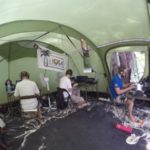
Even on Juan de Nova we had to show our passports and our paperwork to the authorities before we could start about our business. As the leading group made their way to the radio area, the tender made its way back to the yacht. We crossed through the military camp and along the edge of the runway before reaching our spot at the edge of the forest. As we drove along surrounded by our large transportation bags and water containers, excitement continued to grow as we drove past places we had studied in photographs during many months of preparation. Our dream was slowly changing into reality. Suddenly the convoy stopped. Barring our way was a spider as big as your hand. It was very slowly and carefully assisted into the long grass which bordered the track. Eventually, we reach the place we had chosen for our operating positions. The place was much different than we had imagined from the satellite photographs. Admittedly we did not expect to find the lush grass of a golf course freshly mown, but the area left us speechless. It was not possible to establish a site in the long and coarse grass never mind the logistical transport problems. It was also dangerous for team members to cross the field day and night. We discussed the problem with the gendarme, who suggested a tour of the area to allow us to select a better location. Eventually we found a location with no trees which satisfied the environmental constraints of our permit, our proximity to the water, to certain types of vegetation and bird laying areas. We obtained the agreement of the gendarme and also of TAAF.
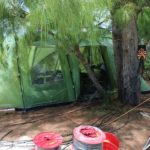
Whilst all this was taking place, the tender had been going back and forth to the yacht bringing more personnel and equipment to the shore to ensure that as much as possible had been brought ashore before low tide. All the equipment was taken to the new campsite and we began to assemble our tents. In a cloudless sky, the temperature gradually rose to 40 degrees. Between the sand and the lack of wind, it was like working in hell. The difficult conditions meant that we had to continually stop to take on board water to keep us hydrated. We worked hard all day and by the time the sun began to set in the sky, the camp was almost complete. We battled against the clock to make the place livable before darkness and the voracious hoardes of mosquitoes which attacked us constantly despite covering ourselves and our clothes in repellant.
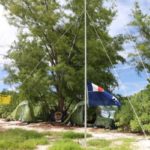
After two days of sailing and one exhausting day working under the hot sun, everybody was exhausted. We made our way to the TAAF buildings, where we enjoyed our first proper meal before retiring to our camp beds to enjoy a few hours of well deserved rest. We awoke before sunrise at 5a.m. Still exhausted from our previous day’s efforts, but fortified by a cup of strong coffee we set out again to complete all that was necessary for the expedition.
Already it was hot, soon it would again be insufferable. We worked to a plan to complete our work. We had to install three generators, which, to avoid contaminating the earth had to be set on large sheets of plastic. This was an important consideration in our plan to safeguard the environment, and in our operating plan agreed with TAAF. All machines started with no problem, having been run up in France prior to our departure. We expected them to work for the duration of our expedition without interruption. We laid out 1,500m of coaxial cable and 2,500m of radials. Electrical connection to the operating positions were also set out. Tent n°1 hosts 3 HF stations whilst tent n°2 has 3 HF stations + 6m.
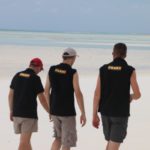
The formation of the operating team is a very important consideration on these adventures. The composition of the team is a crucial point, it is the cornerstone. In addition to operators skills, we made a serious point of forming a cohesive group, with strong human qualities. This proved itself in the fact that for the duration of the trip, the motivation and hard work of the party never failed. The core members of the group had previously been to Tromelin and so the same group went to Juan de Nova joined by some new members whom we felt met all our criteria. During our mid-day break, we had one final opportunity to gather the complete team to remind ourselves of our plan and goals and to discuss matters of operating and general site safety. The world was waiting for us.
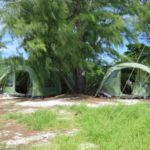
Our first contact was with our chief-pilot station, Cedric F5UKW at exactly 1237z. We were able to get the latest news from France before hitting the airwaves with several stations, soon to be seven in number before the afternoon was over. Operating soon took on a momentum of its own with many stations having waited for decades to make a contact with Juan de Nova. Pile ups were huge and soon a very fast rhythm was established. Those who were not operating, worked outside the operating tent, to make adjustments and tidy up the installation so that the operators could concentrate on making QSOs.
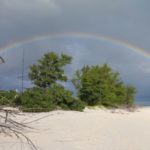
Our band plan was designed to co-habit with VK0EK, the Heard Island expedition which was taking place at the same time. We designed an easy to read, easy to follow table to try to avoid conflict or at least keep it to a minimum. We tried to pay extra attention to those Zones which we though would be the most difficult to contact. Our operating plan was designed so that all regions of the world would have a chance of a QSO with Juan de Nova. It seems the amateur radio community collaborates with our plan without complaining. After the initial rush, the team is split into two so that 24 hour operation is possible. It seems that after the first day of operation there are already 10,000 QSOs in the log. Already we had established a rhythm which we hoped would continue for the duration. Propagation conditions are better than we had hoped for making it possible to make QSOs on the higher bands.
Each station was similarly equipped with an Elecraft K3, an SPE Expert 1.3 KFA amplifier and a Microham Microkeyer II. In addition each station has the necessary band pass filters, homemade splitters, RX limiters loaned by DX Engineering and pre-amplifiers by KD9SV. In addition, SDR transceivers (SunSDR Pro 2) complete the setup and have been used to make some experiments, especially on CW (use of panoramical RX + CW skimmer). These tests have been sucessfull and very interesting with such difficult working conditions in overcrowded bands. All seven stations are networked with WinTest logging software. The antennas of choice were 2 element Vertical Dipole Arrays from 10 to 20m. In addition to their compactness, their performance is undeniable, particulatly so when placed at the Ocean. On 30m and 40m we utilised a four square, with verticals on 80m and 160m using the well known Spiderbeam Poles. A multiband yagi comes in support, in particular to make in-band traffic. This configuration enables us to have, at certain hours, two stations on the same band. The 6m antenna was a 6 element yagi made by DXBeam. All antennas were connected with low loss and extremely light weight coaxial cable manufactured by our Italian partner, Messi and Paolini (Airborne 10). To improve our reception on 160 and 80m, two 200m beverage antennas and phased pennants antennas are in use. Cases lent by DX Engineering and KD9SV enable us to adapt to the configuration.
Every day was different, but we managed to maintain our rhythm of almost 10,000 QSOs per day. We realised that with tiredness setting in, this would be difficult to replicate during the second week. Rest periods were difficult as it was hard to nap in 40 degrees and night time sleep was interrupted as we had to be back in front of the radio for the sunrise openings on the low bands.
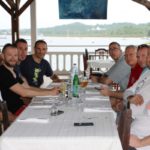
As well as operating, there were also many other things to be taken into consideration. For example, the site has to be maintained, antennas have to be maintained, meals have to be prepared, press releases and articles for schools written, video reports filmed and the like. Every team member is fully occupied and plays their part in the success of the mission. It is the cohesion and integration of all team members that allows this to take place with good humour and hard work. We exchange messages with out pilot station via our sat-phone. Information received allows us to adjust our operating plan taking into account the differences in propogation. At the same time, we have to remain inside our published strategy. Once per day, the log is uploaded to Clublog. This places considerable strain on our data consumption on the sat-phone but on-line logs is a must-have function for expeditions and it seems it is no longer possible not to go down this route.
As the days pass our routines and habits are almost automated. Each day we receive a visit from the gendarme who enquires about our contact total and if we have any problems for him to solve. It is good humoured and his visits were always friendly and appreciated. He was always there to help out and on more than one occasion mobilised the soldiers to carry water and remove waste for re-cycling. We were happy for him to watch our activities and he was intrigued and amazed at how we could communicate with the world using only pieces of wire. One morning, we accompanied him on his daily tour of the Island. His passage checks on pollution, traces of intrusion or anything out of the ordinary which he would report to the Prefect. He would also check on the Island’s turtles and count the number of tracks left by the turtles on the beach overnight. During this tour we discussed many things and it was an enjoyable way to pass the time.
The operating positions are approximately one and a half kilometers from the sleeping tent. Day and night to get from one to the other we have to pass one of the two cemeteries on the Island, and a lighthouse. Near the lighthouse on the beach is the wreck of the Kwang Myong, a 45m Korean ship which foundered in the seventies. Its hull, posed on sand is beaten by the floods with each high tide while the branches of filaos seem to swallow the prow of it. The last 500 meters are done on the beach where it is necessary for us to climb over dead trees lying on the sand. We have been allowed to use a TAAF building near the airstrip. This once housed the weather station (La Goulette) and the gendarmerie, which has since re-located to the main area. This building has toilets and two showers, fed by a tank on the roof. This allows us a little comfort. Our camp beds are set out in the main part of the building intended to lodge scientists during their missions. Rainwater is collected and stored in the tanks. In a concern of saving this invaluable resource, we make our best to collect water from the showers to use it in the toilets or for the laundry.
Last night, the low band operators made contacts under epic conditions, disturbed by the thunderstorms which burst over the ocean each evening. The high bands, almost dead for a few nights were exploited almost until the morning. The stations of the west side of the USA have incredible signals on 20 and 17m. From the start of the expedition, 6m was disappointing with only very short openings to southern Europe (EA, SV, I) and middle East countries making few QSOs possible. A 6m beacon was running each day and we still hoped it might be possible to work stations on EME.
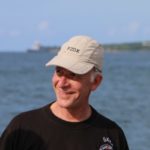
In spite of the adrenalin brought by monstrous pile-up, tiredness is never far and always wins in spite of the regular coffee breaks which push back the limits. In the last resort, we lie down on the ground about twenty minutes before going back to the pile-up. It is necessary to hold on! What a relief when the fresh operators show up at the first gleams of the day. The instructions are exchanged and we give up our seats in order to return to the sleeping area to have a rest. After the re-fueling the three generators and checking the fuel stock, we leave the radio camp. The tide is low, water was withdrawn to the coral reef located at more than one kilometer, letting appear an immense sand field. There’s enormous grey clouds in the sky. In the West direction, a double rainbow show-up and our cameras capture it. The light is splendid.
As we return to the TAAF building, an enormous wind and rain falls down on the island, pouring thousands liters of water, mingled with violent gusts of wind. The roof pours water in torrents. Under the courtyard, we have breakfast but we do not hide our concern about these gusts of winds and its cloudburst. Is the radio camp is flooded? Have the tents resisted the gusts? What about the generators? We are imagining the worst! Maybe this episode means the end of the expedition. In a lull, and in spite of the tiredness, we run up to the radio camp. This kilometer and half felt like ten. We fear how the “battleground” will look like. However, at midway, we perceive the humming of a generator, then see the silhouette of some of our verticals. Once we arrived at the camp, we discover the team running the pile-up peacefully. They managed the crisis very well. There is no damage exept to the capacitive hat of the 160m vertical. Reassured and happy to have escaped this incident without serious consequences, we return to take a few hours of rest, benefitting from the freshness brought by the rain which continues to fall, filling the water reserves of the island.
As we get towards the end of the second week we are looking to break the 100,000 QSO mark. This target is all consuming. We activate the whole seven station whenever possible. The QSOs are fast and furious. There is at least one station on 15m throughout the 24 hour period in order to maximise QSOs especially uniques.
6m EME proved disappointing and did not lead to a complete 2-way contact. However, it is all the more infuriating, our signals were heard and we received several reports, without never having the time necessary to complete the contact. The density of the filaos and the obstacle formed by the lighthouse placed exactly on the azimuth of the Moon did not certainly play in our favour. However, this is a challenge worth taking on ! Except for some small fixes, we did not have any problem with equipment. The equipment chosen shows an incredible reliability in spite of difficult conditions of operating (heat, salt air, operation around the clock, etc).
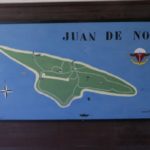
Three days before the end of our mission, it was necessary for us to complete the reports and interviews which will be used for the video of the expedition. With this intention, we leave the camp at dawn in order to benefit from the exceptional light. At the end of the landing track, several cottages house the equipment of weather stations from which the data is transmitted automatically. The first permanent station goes back to 1973, taking over the 20 year old auxiliary station called “ La Goulette” in reference to the Captain Marcel Goulette who was constrained to land on Juan de Nova with his Farman 190 in 1929. He left about two months later, having arranged a rough track. Nowadays, at 1200m, it is the essential link with the outside and makes it possible for military planes to carry out the changing of staff every 45 days.
We go along the track bordered by tall filaos which is without any doubt the most represented species of trees on the island. The flora is relatively poor. Some coconuts, vestiges of an old copra plantation are drawn up close to the TAAF building. At the top of beach, we note the presence of some “velvet trees”. The heart of the island is a patchwork of vast clearings covered with high grasses and more wooded parts. At mid- track, we turn and we enter the forest. We keep our eyes open because these underwoods are a hunting ground for the big spiders which weave immense inclined webs while waiting for their prey. The way curves to a clearing where there is a large stone house. Although in ruins, the “Patureau house” appears massive with its two levels, perched on a vast concrete base. Its imposing staircases and its ironwork give it an air of a mansion.
In 1952 Hector Patureau obtained, from the French government, a concession to extract guano in Juan de Nova. Phosphate is used as fertiliser. The exploitation thrived and employed many workers. The Patureau House was constructed during this period. When the phosphate prices collapsed, the work closed at the end of the Sixties. The last workers left the island in 1975. Today, only ruins of this short industrial adventure remain and are slowly being absorbed by the vegetation. The path which leads towards the East leads us to the SEGA camp which hosts the military detachment, installed partly in the buildings which formerly lodged the workers. Then, we head in direction of the beach and pass in front of the dechetery of the island where all rubbish is carefully sorted. All collected waste, including that collected from the beach is gathered there. Regularly, this material is removed from the island then recycled. On the ground, sections of rails which were used to convey the “Decauville railway carriage” full of phosphate still exist. We follow them to the bottom of the old pontoon, partly collapsed which stretches out into the lagoon. In other times, the ore was loaded onto boats before transportation to Europe.
Time passes too quickly. It is time to go back at radio camp to replace our comrades who ensured the morning radio operation. We go along the beach, escorted by several raven-magpies which follow us in silence, rather than their normal loud chatter. In a general way, we were surprised by the calm of the island. The terns which we had had the chance to see and live alongside throughout our stay in Tromelin had already left the island after the period of nesting (2 million couples of sooty terns). Only some small red fody were seen during our stay, perched in height to perhaps secure attacks of wildcats. They were introduced to fight against the proliferation of rats but it is mainly in the population of terns that suffer. An eradication campaign of the wildcats is in progress.
We do not have the chance to renew the magic meeting with the turtles leaving water to go to lay their eggs in the sand, not even a single opportunity of seeing the characteristic tracks in sand. Our authorisation only permitted us to erect our tents not to exceed the first line of vegetation so as not to disturb the turtles. We had to follow a similar instruction with our antennas and in addition had to attach coloured ribbons to all guy wires to make them visible to the birdlife.
In the same way as we had to plan our arrival, we had to carefully plan our departure from the Island. We had to take into account the state of the tide and the hight of the swell. One by one we removed the antennas and carefully loaded our tender one generator at a time. By the final afternoon, we had only one generator, 4 HF stations, 5x VDA and a vertical for 40m and 30m. Everything else was back on the yacht.
During the last evening we each took a turn at operating to allow us all to experience the pileup one last time. We had already surpassed our target of 100,000 contacts but our enthusiasm did not waver. Our last QSO took place at 2100z on 10th April after twelve days and eight hours. In total we had 105,600 QSOs in our log.
Next morning, it was a race against time to dismantle everything that remained and have it removed from the Island back to the yacht, before the turn of the tide. We were fortunate that there was no wind and the conditions were good. As the last load of equipment left on the tender, we examind our site very carefully to ensure we left everything as we found it. It was very difficult to tell that we had even been there. This had to be done to comply with our landing and operating permit. The tide had now turned and the team had to wait for the next tide to leave the Island. They made use of their last moments on the Island to make one final meal using all the left over food. It also gave us the opportunity to have a look at the logs and our statistics. Our initial look showed that we made 60% of all QSOs with Europe, 21% with North America and 16% with Asia. We were happy to have achieved our objectives and allowed many amateur radio friends all over the World to make at least one contact with this very rare and remote Island. We were also very proud that it was an entirely French expedition with the exception of Christian EA3NT, but after two weeks of being with the team, he became almost French, and that we were able to overcome some very complex and difficult problems. We were also able to demonstrate that it is possible for amateur radio and wilflife conservation to co-exist without detriment to the environment. We would like to thank everybody who helped in one way or another to make this adventure possible, for their advice, for their benevolence in helping us around the various complicated issues of visiting such a remote wilderness.
We cannot finish this long story without warmly thanking all those who supported and helped us starting with companies Elecraft, SPE Expert, Spiderbeam, DX Engineering, KD9SV, Microham, Messi & Paolini, DX Avenue, GM0OBX Cables, SunSDR.eu, ExpertElectronics, Antlion Audio, F5JRC Print Shop.
On all the continents, the clubs and foundations have been reactive in spite of a complicated season for their finances because of many expeditions in search of sponsors. An immense thank you to Northern California DX Foundation, as well as the International DX Association, German DX Foundation, Network of the French Transmitters, Clipperton DX Club, Colvin Award, Southeastern DX Club, Chiltern DX Club, Twin City DX Association, Eastern Iowa DX Association, NIDXA, Danish DX Group, European DX Foundation, Mediterraneo DX Club, OHDXF, Carolina DX Assocation, Willamette Valley DX Club, Swiss DX Foundation, Lone Star DX Assocation, Northern California DX Club, the U.K. Six Meter Group, ORCA, CQ Hamradio JA, Western Washington DX Club, F8ATS Stamp fund, ETDXA, the DX Group, GMDX Group, FEDXP, WVDXA, eQSL, Ehime DX, Utah DX, Tokyo 610, TDXS, SEMDXA, Lynx DX, GSDXA, Shizuoka DX, Delta DXA, RemoteHamradio.com, UFT, LIDXA, 599DX, NWIDXA, NOHDXA, ADXA, Nara DXA, Mile-Hi DXA, OKDXA, SEDCO, Passau DX, FWDXA, Mulan DX, GMDXA, KC5WXA, Spokane DXA, Madison DX, NADXC, SDXG, WNYDXA, GPDX, BARTG, DX Hogs, Most Wanted DX, Yokohama DXC, ARAN59, VADXCC, Six Italia.
We wish to underline the exceptional help of the amateur radio community through all the people who took part in the project. Thanks to F6AGM, K1QX, F4ERS, F6BKI, F5VHJ, K6TU, N5FG, JA4DND, F5JRC, our pilots F5UKW, JJ3PRT, W0MM, ON9CFG.
In conclusion, we wish to thank cordially the staff of the French Southern Lands and Antarctic (TAAF) and its Prefect, the administrator of the TAAF, Mrs Cécile Pozzo di Borgo who authorised us to carry out this mission and provided constant support during all the preparation.
While we are writing these last lines, Juan de Nova is nothing any more but a dot on the horizon. We leave with a head full of memories, the SD cards of our camera boards crowded with photographs and videos and 100000+ contacts in the log. There is no doubt that the actions of conservation done by the TAAF will make it possible to protect this marvellous island, and that one day perhaps, we may have the opportunity to visit again.
FT4JA,
Seb F5UFX & Flo F5CWU (adaptation Tom GM4FDM)
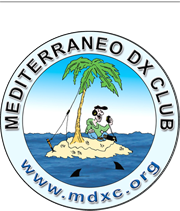

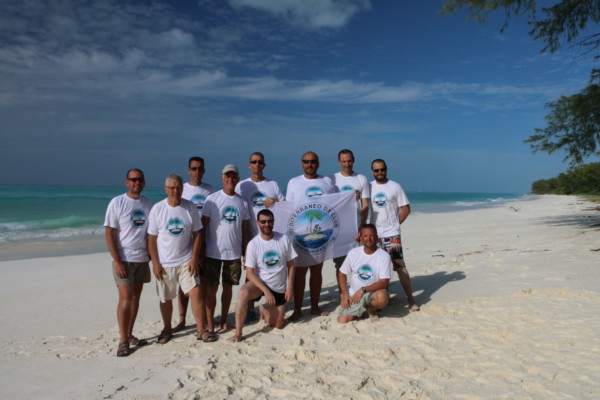
 3B9DJ Rodrigues
3B9DJ Rodrigues  TX7N Marquesas
TX7N Marquesas

